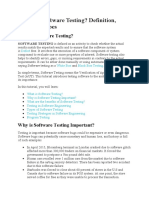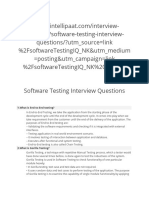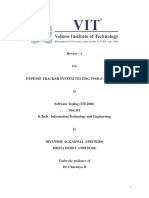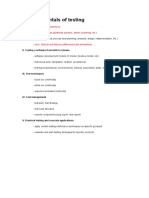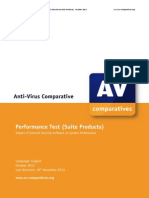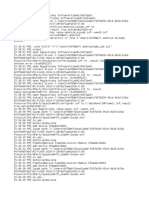Continental Test Lab: August 2014
Continental Test Lab: August 2014
Uploaded by
Ana MariaCopyright:
Available Formats
Continental Test Lab: August 2014
Continental Test Lab: August 2014
Uploaded by
Ana MariaOriginal Description:
Original Title
Copyright
Available Formats
Share this document
Did you find this document useful?
Is this content inappropriate?
Copyright:
Available Formats
Continental Test Lab: August 2014
Continental Test Lab: August 2014
Uploaded by
Ana MariaCopyright:
Available Formats
Continental Test Lab
August 2014
Interior Infotaiment and Connectivity R&D Romania
Agenda
1Day 1 - The need of testing, Principles of testing, SDLC
2Day 2 - Test Levels and Functional Testing
3Day 3 - Non-functional testing and Defect LifeCycle
4Day 4 - Test Types
5Day 5 - Test techniques
6Day 6 - Discussion over homeworks
Interior Infotaiment and Connectivity R&D Romania
2 11-03-26 Autor, © Continental Automotive Romania SRL
Table of contents
1Test Levels
2Functional testing
Interior Infotaiment and Connectivity R&D Romania
3 11-03-26 Autor, © Continental Automotive Romania SRL
Test Levels
Test Levels
Testing is performed at different levels involving the complete system or parts of
it throughout the life cycle of a software product
A software system goes through four stages of testing before it is actually
deployed:
Unit/Component
Integration
System
Acceptance
The first three levels of testing are performed by a number of different
stakeholders in the development organization, where as acceptance testing is
performed by the customers
Interior Infotaiment and Connectivity R&D Romania
18 August 2014 , © Continental Automotive Romania SRL
Test Levels – Component testing
Component testing
Component testing (also known as unit, module or program testing) searches
for defects in and verifies the functioning of software modules, programs,
objects, classes.
Component testing occurs with access to the code being tested and with the
support of a development environment such as a unit test framework or
debugging tool.
One approach to component testing is to prepare and automate test cases
before coding (this is called a test-first approach or test-driven development)
Interior Infotaiment and Connectivity R&D Romania
18 August 2014 , © Continental Automotive Romania SRL
Test Levels – Component testing
Component testing
Button from an Xbox Controller
We can test the 4 directions
We can test that on press it triggers an event
We can test that on continuous press it triggers multiple events
We can test 2 directions at once
Interior Infotaiment and Connectivity R&D Romania
18 August 2014 , © Continental Automotive Romania SRL
Test Levels – Component testing
Component testing
Microsoft Paint – Color tab
Select the red color
Enter in the edit colors menu and select magenta
Select the second Color tab
Interior Infotaiment and Connectivity R&D Romania
18 August 2014 , © Continental Automotive Romania SRL
Test Levels – Component testing
Component testing
Printer – Ink Cartridge Slot Component
Insert the Colored Cartridge into the slot
Insert an empty Colored Cartridge into the slot
Insert a B&W Cartridge into the Colored Cartridge slot
Check if the contacts of the Slot are in the proper order
Interior Infotaiment and Connectivity R&D Romania
18 August 2014 , © Continental Automotive Romania SRL
Test Levels – Integration testing
Integration testing
Integration testing tests interfaces between components, interactions with
different parts of a system, such as the operation system, file system and
hardware, and interfaces between systems.
There may be more than one level of integration testing:
Component integration testing tests the interactions between software
components and is done after component testing
System integration testing tests the interactions between different systems or
between hardware and software and may be done after system testing
The greater the scope of integration, the more difficult it becomes to isolate
defects to a specific component or system, which may lead to increased risk
and additional time for troubleshooting
Interior Infotaiment and Connectivity R&D Romania
18 August 2014 , © Continental Automotive Romania SRL
Test Levels – Integration testing
Integration testing
Xbox Controller connected to a console
Check the data flow from pressing a button
to the controller CPU and transmission chip
Verify the wireless reconnection of the controller to
the console on start
Check the data flow between controller and
console on multiple button presses
Press the menu button, the event is sent to the
console and the menu is visible on the screen
Interior Infotaiment and Connectivity R&D Romania
18 August 2014 , © Continental Automotive Romania SRL
Test Levels – Integration testing
Integration testing
Microsoft Paint
Check that when selecting a new brush,
the event is sent to the OS and the mouse
icon is switch to the new brush
Copy a image to the clipboard and try to paste it into Paint
Save the new picture to the E drive and check if the file is saved to the file system
Open a bitmap file from D drive
Interior Infotaiment and Connectivity R&D Romania
18 August 2014 , © Continental Automotive Romania SRL
Test Levels – Integration testing
Integration testing
Printer
Remove the paper from the tray slot and print
(The detection module for the paper will need to inform the main module that there is no
prepare, so the printing is cancelled)
Install the printer on windows XP, open document X in MS Word and print
Open the printer without a Cartridge inserted
(the system will detect the missing cartridge and inform on power on event)
Interior Infotaiment and Connectivity R&D Romania
18 August 2014 , © Continental Automotive Romania SRL
Test Levels – System testing
System testing
System testing is concerned with the behavior of a whole system/product.
The testing scope shall be clearly addressed in the Master and/or Level Test
Plan for that test level.
In system testing the test environment should correspond to the final target or
production environment.
System testing may include tests based on risks and/or on requirements
specifications, business processes, use cases or other high level text
description or models of system behavior.
Interior Infotaiment and Connectivity R&D Romania
18 August 2014 , © Continental Automotive Romania SRL
Test Levels – System testing
System testing
Move the right joystick up
Press the Y button and then the A button
While in Menu press the Back button
Move the left joystick in all directions
Remove the batteries from the controller
Interior Infotaiment and Connectivity R&D Romania
18 August 2014 , © Continental Automotive Romania SRL
Test Levels – System testing
System testing
Draw a red line with brush 1 and size 2
Select the shape Circle
Change the color to Green
Draw a Circle
Access the Edit Colors menu
Select from tools the bucket
Change the color to green
Use the bucket to change background in green
Interior Infotaiment and Connectivity R&D Romania
18 August 2014 , © Continental Automotive Romania SRL
Test Levels – System testing
System testing
Power on the printer and print in color document X
Print in black and white on two sides the document Y
Print a document Z with high quality preset
Leave the printer powered on for one week
Print document R at high speed with low quality preset
Check the alignment in page
Interior Infotaiment and Connectivity R&D Romania
18 August 2014 , © Continental Automotive Romania SRL
Test Levels – Acceptance Testing
Acceptance testing
Acceptance testing is a test conducted to determine if the requirements of a
specification or contract are met.
The goal is to establish confidence in the system, parts of the system or
specific non-functional characteristics of the system.
Finding defects is not the main focus in acceptance testing.
Typical forms of acceptance testing include the following:
User acceptance testing – verifies the fitness for use of the system by business users.
Operational testing – the acceptance of the system by system administrators (testing of
backup,disaster recovery, user management, data load and migration tasks)
Contract and regulation acceptance testing – is performed against a contract`s acceptance
criteria for production custom-developed software
Alpha and beta (or field) testing – software often want to get feedback from potential or
existing customers in their market before the software product is put up for sale
Interior Infotaiment and Connectivity R&D Romania
18 August 2014 , © Continental Automotive Romania SRL
Test Levels – Acceptance Testing
Acceptance testing
The product can be launched for a Alfa or Beta testing
The functions from the controller are respecting
the contract
The buttons alignment are right
The grip is as requested
Interior Infotaiment and Connectivity R&D Romania
18 August 2014 , © Continental Automotive Romania SRL
Test Levels – Acceptance Testing
Acceptance testing
Is it compatible with Windows 7 and 8 as in contract?
The setup works as expected
The GUI layout respects the specifications
Interior Infotaiment and Connectivity R&D Romania
18 August 2014 , © Continental Automotive Romania SRL
Test Levels – Acceptance Testing
Acceptance testing
Behavior at increasing speed
Density printing profile is respected
Color density fluctuations
Alignment check
Interior Infotaiment and Connectivity R&D Romania
18 August 2014 , © Continental Automotive Romania SRL
Test Levels – Verification and Validation
The four stages of testing have been illustrated in the form of what is called the
classical V
Interior Infotaiment and Connectivity R&D Romania
18 August 2014 , © Continental Automotive Romania SRL
Test Levels – Verification and Validation
Verification
"The process of evaluating a system or component to determine whether the products of a
given development phase satisfy the conditions imposed at the start of that phase.“
Verification simply demonstrates whether the output of a phase conforms to the input of a
phase as opposed to showing that the output is actually correct.
Verification will not detect errors resulting from incorrect input specification and these
errors may propagate without detection through later stages in the development cycle.
According to IEEE Std 1012-1998/2004
Interior Infotaiment and Connectivity R&D Romania
18 August 2014 , © Continental Automotive Romania SRL
Test Levels – Verification and Validation
Validation
"The process of evaluating a system or component during or at the end of the
development process to determine whether it satisfies specified requirements.“
It is not enough to only depend on verification, so validation is necessary to check for
problems with the specification and to demonstrate that the system is operational
“A written guarantee that a system or component complies with its specified requirements
and is acceptable for operational use."
According to IEEE Std 1012-1998/2004
Interior Infotaiment and Connectivity R&D Romania
18 August 2014 , © Continental Automotive Romania SRL
You might also like
- IS Encryption GuideDocument34 pagesIS Encryption GuideAlyssaBereznak100% (1)
- Airline Reservation Systems ADocument4 pagesAirline Reservation Systems AMuhammad Kashif Saeed AnsariNo ratings yet
- FAPT Ladder For PC-Operator ManualDocument302 pagesFAPT Ladder For PC-Operator ManualSebautomatisme0% (1)
- M Saab 3Document316 pagesM Saab 3Sarang Shinde67% (3)
- Continental Learning Lab: August 2014Document67 pagesContinental Learning Lab: August 2014Ana MariaNo ratings yet
- Continental Learning Lab: August 2014Document15 pagesContinental Learning Lab: August 2014Ana MariaNo ratings yet
- Continental Test Lab: August 2014Document18 pagesContinental Test Lab: August 2014Ana MariaNo ratings yet
- Vipul Jain SynopsisDocument6 pagesVipul Jain SynopsisHitesh BhattNo ratings yet
- Ch8.SoftwareTesting_34Document34 pagesCh8.SoftwareTesting_34mohamad.alshouha2001No ratings yet
- 4 SeDocument17 pages4 SeSathishkumar MNo ratings yet
- Continental Test Lab: August 2014Document20 pagesContinental Test Lab: August 2014Ana MariaNo ratings yet
- Ch6 Software TestingDocument62 pagesCh6 Software Testingabdulbaset alselwiNo ratings yet
- Ch8.TestingDocument64 pagesCh8.Testingaljm68019No ratings yet
- Software Testing-With NotesDocument66 pagesSoftware Testing-With NotesAbhishek Kumar SinghNo ratings yet
- Sec 10 Computer Applications To Quality SystemsDocument17 pagesSec 10 Computer Applications To Quality Systemsapi-3699912No ratings yet
- Sunil Venkata Chaganti: EmailDocument3 pagesSunil Venkata Chaganti: EmailPrudhvi RamNo ratings yet
- Manual Testing Notes - TheTestingAcademyDocument53 pagesManual Testing Notes - TheTestingAcademyShayak KaranNo ratings yet
- Darsh STQA1Document12 pagesDarsh STQA1ronipatel193No ratings yet
- UNIT-V - NotesDocument32 pagesUNIT-V - Notespoojasai235No ratings yet
- Swhat Is Software Testing? Definition, Basics & TypesDocument27 pagesSwhat Is Software Testing? Definition, Basics & TypesMohan KrishnaNo ratings yet
- Manual Testing Notes - TheTestingAcademyDocument66 pagesManual Testing Notes - TheTestingAcademydeepakguptarkshNo ratings yet
- Lecture # 13 - Software Test AutomationDocument29 pagesLecture # 13 - Software Test Automationaffanabbasi015No ratings yet
- Ch 6 Software TestingDocument21 pagesCh 6 Software TestingRED TABNo ratings yet
- Software Engineer notes unit 4Document29 pagesSoftware Engineer notes unit 4premrajora90501No ratings yet
- 1what Is Software Testing - Definition, Basics & Types in Software EngineeringDocument6 pages1what Is Software Testing - Definition, Basics & Types in Software EngineeringFlorin ConduratNo ratings yet
- TheTestingAcademy - Part 1 Manual Testing NotesDocument17 pagesTheTestingAcademy - Part 1 Manual Testing Noteskeror89732No ratings yet
- System TestingDocument8 pagesSystem TestingGJASHGFANo ratings yet
- MODULE 2-Se 3rd ChapDocument29 pagesMODULE 2-Se 3rd ChapZeha 1No ratings yet
- Automated System Testing using Visual GUIDocument10 pagesAutomated System Testing using Visual GUIZahra WaheedNo ratings yet
- Implementation of Software Testing Using Any LanguageDocument14 pagesImplementation of Software Testing Using Any LanguageaddssdfaNo ratings yet
- Verification and Validation: Ian Sommerville, SW Engineering, 7th/8th Edition CH 22Document49 pagesVerification and Validation: Ian Sommerville, SW Engineering, 7th/8th Edition CH 22Michael ArielNo ratings yet
- Fresher Q&A For Testing 1Document16 pagesFresher Q&A For Testing 1shahanwazNo ratings yet
- Manual Testing Vs Automation TestingDocument23 pagesManual Testing Vs Automation TestingHaribabu PalneediNo ratings yet
- Softwatre TestingDocument33 pagesSoftwatre TestingFarhan SjNo ratings yet
- App T Da Pam 73-1 SDocument4 pagesApp T Da Pam 73-1 SAriawan RachmantoNo ratings yet
- Module 4Document23 pagesModule 4manu809546No ratings yet
- Chapter 8 - Software TestingDocument29 pagesChapter 8 - Software TestingPusba NathanNo ratings yet
- Unit 4Document122 pagesUnit 4kuberNo ratings yet
- Best Practices in Mobile Quality Assurance and Testing PDFDocument9 pagesBest Practices in Mobile Quality Assurance and Testing PDFDso AnakpanahNo ratings yet
- INFS3203 Systems Deployment and Implementation: Dr. Seifeddine BouallegueDocument37 pagesINFS3203 Systems Deployment and Implementation: Dr. Seifeddine BoualleguefgfdgfdgfdNo ratings yet
- Software Testing Q&ADocument5 pagesSoftware Testing Q&AasimNo ratings yet
- GUI TestingDocument16 pagesGUI TestingMohamed Shajid NNo ratings yet
- Levels of TestingDocument5 pagesLevels of TestingRoshanNo ratings yet
- Software Testing Viva Questions and Answer Mca Sem5Document11 pagesSoftware Testing Viva Questions and Answer Mca Sem5Unknown100% (5)
- הנדסת תוכנה- הרצאה 8Document18 pagesהנדסת תוכנה- הרצאה 8RonNo ratings yet
- Software Testing - ProjectDocument16 pagesSoftware Testing - ProjectDivanshu AggarwalNo ratings yet
- CS335 Testing LectureDocument64 pagesCS335 Testing LectureDoreen EmmanuelNo ratings yet
- Lecturer: Sebastian Coope: Ashton Building, Room G.18 E-Mail: Coopes@liverpool - Ac.ukDocument29 pagesLecturer: Sebastian Coope: Ashton Building, Room G.18 E-Mail: Coopes@liverpool - Ac.uksdgpass2585No ratings yet
- Ch8.Testing10the EdDocument66 pagesCh8.Testing10the EdAmjad BashayrehNo ratings yet
- Extra ContentsDocument6 pagesExtra Contentsanand_gsoft3603No ratings yet
- 1 Formal MethodsDocument20 pages1 Formal Methodsthawtar2449889No ratings yet
- CH 0005Document50 pagesCH 0005FreezingSoul FreezingSoulNo ratings yet
- Automation and TesteniumDocument66 pagesAutomation and Testeniumrohit.pandhare1996No ratings yet
- 1 Chapter 8 Software TestingDocument60 pages1 Chapter 8 Software TestingOriflame KozmetikaNo ratings yet
- Unit IV Chapter13Document16 pagesUnit IV Chapter13Suresh RamanujamNo ratings yet
- RGPV Unit-4-SEM-Software Testing and Maintenance 2024Document44 pagesRGPV Unit-4-SEM-Software Testing and Maintenance 2024OverKill Ghost GamingNo ratings yet
- Open Source Software Test Automation ToolsDocument8 pagesOpen Source Software Test Automation ToolslitianNo ratings yet
- manualTesting_interviewquestionDocument14 pagesmanualTesting_interviewquestionಚಂದನ್ ಗೌಡNo ratings yet
- Unit5 1Document32 pagesUnit5 1HarigopalNo ratings yet
- Chapter 1 - What Is Software TestingDocument5 pagesChapter 1 - What Is Software TestingAamir AfzalNo ratings yet
- A Strategy For Testing C++: White PaperDocument22 pagesA Strategy For Testing C++: White Paperapi-242168770No ratings yet
- SE2021-Ch8-Testing-part IDocument37 pagesSE2021-Ch8-Testing-part IYunusNo ratings yet
- 6 TestingDocument5 pages6 Testingdeva702000No ratings yet
- I. Fundamentals of Testing: Definition and Objectives Testing Principles (Pesticide Paradox, Defect Clustering, Etc.)Document1 pageI. Fundamentals of Testing: Definition and Objectives Testing Principles (Pesticide Paradox, Defect Clustering, Etc.)Ana MariaNo ratings yet
- Introduction ToDocument49 pagesIntroduction ToAna MariaNo ratings yet
- Introduction ToDocument112 pagesIntroduction ToAna MariaNo ratings yet
- Continental Test Lab: September 2014Document38 pagesContinental Test Lab: September 2014Ana MariaNo ratings yet
- Continental Test Lab: August 2014Document20 pagesContinental Test Lab: August 2014Ana MariaNo ratings yet
- Point in Time Recovery Using RmanDocument3 pagesPoint in Time Recovery Using RmanShantha KumarNo ratings yet
- D2XX Programmer's Guide (FT 000071) 3Document112 pagesD2XX Programmer's Guide (FT 000071) 3own-mineNo ratings yet
- H.264 Tutorial Using Ripbot264 (DVD and Blu Ray!) : Here?Document49 pagesH.264 Tutorial Using Ripbot264 (DVD and Blu Ray!) : Here?Angie Lin100% (1)
- 50 Tricks and Hacks Which You Don't Know About Your PC - TalkToDocument46 pages50 Tricks and Hacks Which You Don't Know About Your PC - TalkToSachin KumarNo ratings yet
- Complete Integrated Science 7th Edition Bill W. Tillery - Ebook PDF PDF For All ChaptersDocument25 pagesComplete Integrated Science 7th Edition Bill W. Tillery - Ebook PDF PDF For All Chaptersupkarhulvej100% (4)
- Lua App Creation TutorialDocument671 pagesLua App Creation TutorialsbnurNo ratings yet
- CSS Tricks - Modern and Advanced Techniques For 2022Document20 pagesCSS Tricks - Modern and Advanced Techniques For 2022Miguel A. Ostos S.No ratings yet
- Backing Up and Restoring HP Systems Insight Manager 7.2 or Greater Database in A HP-UXDocument15 pagesBacking Up and Restoring HP Systems Insight Manager 7.2 or Greater Database in A HP-UXVikram ReddyNo ratings yet
- ChamSys MagicQ ConsolesDocument1 pageChamSys MagicQ ConsolesChamSysNo ratings yet
- Introduction To PTC Windchill PDM Essentials 11.1 For Light UsersDocument6 pagesIntroduction To PTC Windchill PDM Essentials 11.1 For Light UsersJYNo ratings yet
- Vista IntroductionDocument131 pagesVista Introductionmekkouk9No ratings yet
- Marketing Cloud Email Specialist DemoDocument7 pagesMarketing Cloud Email Specialist DemodongchengccNo ratings yet
- CSP Create PDFDocument25 pagesCSP Create PDFMartin Sebastian Gomez GalizziNo ratings yet
- ISR NgrokDocument2 pagesISR NgrokmokshiiitNo ratings yet
- Final Revision G8Document20 pagesFinal Revision G8youssef.mohamed.anwooNo ratings yet
- Rel 3.0.0.30092021 - CloudSAMS SchoolsDocument5 pagesRel 3.0.0.30092021 - CloudSAMS SchoolsTest 4No ratings yet
- ITC Paperless Conference System IntroductionDocument52 pagesITC Paperless Conference System Introductionjudy kimNo ratings yet
- Kingston Toolbox 2.0 Firmware Update Procedure: Intended ForDocument4 pagesKingston Toolbox 2.0 Firmware Update Procedure: Intended ForcherandinhoNo ratings yet
- Windows10 All ChaptersDocument116 pagesWindows10 All Chaptershazha minaNo ratings yet
- Anti-Virus Comparative: Performance Test (Suite Products)Document13 pagesAnti-Virus Comparative: Performance Test (Suite Products)HeryNo ratings yet
- Microsoft OfficeDocument1 pageMicrosoft OfficesatyamkingNo ratings yet
- JIRA RespuestasDocument4 pagesJIRA RespuestasDavid OlánNo ratings yet
- Using The 5e TemplateDocument2 pagesUsing The 5e TemplateMithat ZenginNo ratings yet
- Ejemplo de Ensayo de 250 PalabrasDocument6 pagesEjemplo de Ensayo de 250 Palabrasg6acfvzv100% (1)
- 0 Faade 219904@20194917571Document4 pages0 Faade 219904@20194917571Mikayrie D. DulayNo ratings yet
- Digital Advertising BasicsDocument1 pageDigital Advertising BasicsJanzNadalesNo ratings yet



















